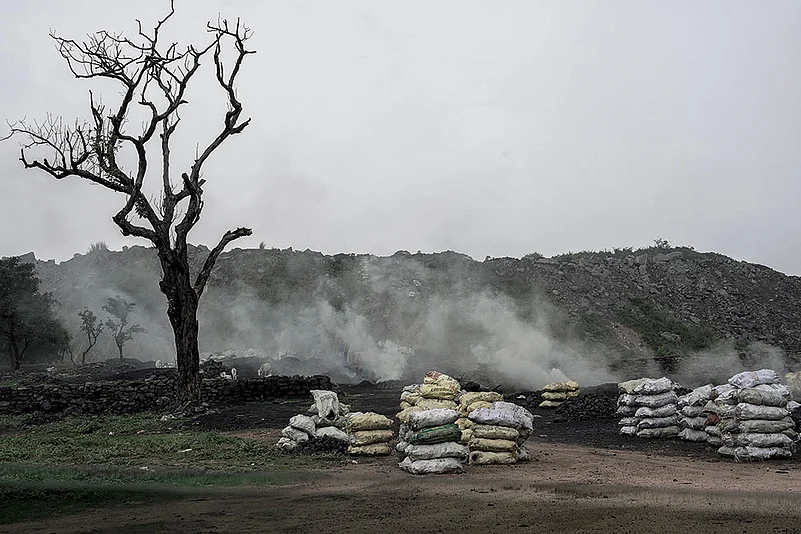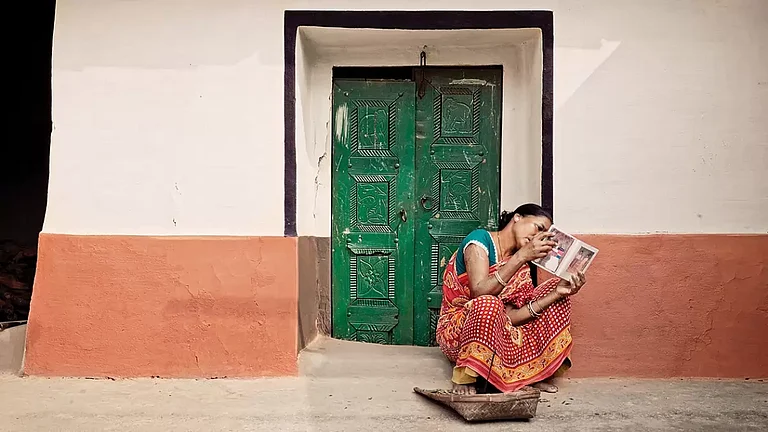As soon as we entered Tapin basti in Ramgarh district of Jharkhand, a siren went off. It seemed like a warning of sorts. After a few moments, there was a blast; so loud that our ears went numb, and it seemed that the ground shook for a moment. It felt like an earthquake. People living in this village experience such earthquakes, caused due to incessant mining in the nearby areas, many times a day—the only difference being these come with a warning; sirens are sounded ten minutes before and after the blast.
Tapin is one of the dozens of villages in the district where unrestricted coal mining has created deep pits; some are more than a thousand feet deep. Lobin Lugun, 60, lives close to one such pit. He has been living here since 1973. His ancestors were here even before that. They made the forest liveable. No one stopped them. For generations. Now, they are being told that they are illegal occupants. Despite living close to the toxic pits, this is their home. They have nowhere else to go to. “We do not own even an inch of land apart from this house. If we are not rehabilitated, where will we go? We earn our living in the nearby areas and feed ourselves. But how will we earn a living now, how will feed ourselves?” asks Lugun.
This worry consumes all the households in the basti, which number about 120. This is because of the notice they received on September 30, 2023, which termed their settlement illegal, asked them to vacate their homes within a week and threatened them with action if they failed to do so. It is now nine months since the notice, but the residents are not ready to vacate their homes. At the moment, they are fighting a battle for rehabilitation while putting their lives at risk.
In Ramgarh and Hazaribagh districts, there are many such coal mines that have uprooted hundreds of Dalit and Adivasi villages. It is difficult to make a count of the total number of villages across Jharkhand that have been destroyed by the mines. According to a report by the Indian Council of Social Science Research, 1.5 million people have been displaced in the country between 1951 and 1995 due to mining and other development projects. There is no precise data available after this.
Officially, Jharkhand has a 40 per cent share of the total mining of the country. Primarily, coal, bauxite, iron ore and mica reserves are aplenty here. As such, Jharkhand is a very rich state. But in spite of this, the people of this state are among the poorest in the country. According to the 2021 NITI Aayog report, Jharkhand is the second-poorest state in the country, after Bihar.
Mining-induced Ecological Deterioration
Mining in Jharkhand has not just uprooted villages, it has uprooted forests on an even larger magnitude. Its impact can be easily understood by the imbalance caused in the seasons. State capital Ranchi and the plateaus of Latehar and Gumla were among the cities that were known as hill stations, but now even these pockets are experiencing intense heat waves. In 2022, many districts in Jharkhand saw temperatures soar to 46 degrees Celsius. For the first time in 23 years, Ranchi did not see even a day of rainfall in the month of April.
The maximum temperature in Ranchi, which would usually stay between 38 and 40 degrees, is now recorded in the range of 42-43 degrees in recent years. Latehar and Gumla, which commonly saw maximum temperatures go up to only 30 degrees, are now recording a temperature of around 38 degrees. This year, the maximum recorded temperature in Jharkhand was above 47 degrees.
Experts hold mining activities in the state responsible for these environmental changes in Jharkhand. About 200 km away from Ranchi, on the borders of Gumla and Latehar districts, are thousands of settlements that belong to primitive tribes of the Asur community. Their lives had already been adversely affected due to bauxite mining in the region. Now, the intense and prolonged heat waves are adding to their misery.
“We live in Sakhuapani village. For the past few years, we have been suffering due to hot winds (loo). This summer, 10-12 people died due to heatstroke caused by the hot winds,” says Sushma Asur, 37. “Plateaus never used to be this warm. Our village used to remain cool during summers. There are other issues like polluted air and water. When it rains, the stream water becomes red because of the mining, and we are forced to drink that same water. The summer breeze carries mining dust and fills our kitchen utensils with it.” She believes that the deforestation that has taken place all around due to mining is what has caused these massive changes in the plateaued region.
Mining in Jharkhand has uprooted many forests. Its impact can be easily understood by the imbalance caused in the seasons.
However, there is no reliable data on the total area under mining. A big reason for this is also the existence of large-scale illegal mining in the state. In 2008 and from 2022 to 2023, the central government approved the transfer of 305,000 hectares of forest land for non-forest use under 17,301 projects. During this time, a fifth of the total forest cover, that is, 58,282 hectares, was destroyed for mining alone, of which 15,691 hectares were from Jharkhand.
According to environmentalists, sal trees play a crucial role in maintaining the ecological balance in Jharkhand, as they are tall, and their branches have leaves during most of the year. In India, Jharkhand’s forests have the highest number of sal trees. In Western Singhbhum district, the Saranda forests spread over 82,000 hectares are known for the densest sal forests in Asia. Several studies and media reports have stated that the iron ore mining here has destroyed these forests on a large scale.
While talking about the importance of sal trees, environmentalist and professor DS Srivastava says: “The biggest challenge for the ecology is the large-scale destruction of sal trees that were spread all across the plateaus and were responsible for the cool climate. When the southwestern monsoon would enter here from Chhattisgarh, this cool weather would pull the clouds in and cause rains here. I believe that the large destruction of sal trees for Bauxite mining is the biggest cause of climate change here.”
Shifting Monsoons and Lives Made Sick by Mining
Mining has damaged the ecology in Jharkhand at multiple levels. It has laid waste the fields of Adivasis. Their natural sources of water have been polluted. Respiratory diseases are choking them. The state is repeatedly seeing droughts. Jharkhand has faced 15 droughts in the last 23 years.
Experts say repeated droughts signify climate change caused by mining, deforestation and the disruption of the local ecological balance. Significantly, these causes have led to a gradual shift in the monsoons in the state. The farmers have felt the brunt of this shift the most, in the past two decades.
According to the weather department, from 1961 to 2010, the monsoon used to arrive every year in Jharkhand any day from 5-10 June. From 1971 to 2020, this shifted to 10-15 June. At the same time, normal rainfall has also been affected in the state. In the past 70 years, rain here has also witnessed changes. From 1951 to 2000, 1,091.9 mm was the normal rainfall, which reduced to 1,054.7 mm between 1961 and 2010, and fell further to 1,022.9 from 1971 to 2020.
Climate change has been a double curse for the farmers as the formations of plateaus had already made irrigation difficult. Being a plateau-majority state, there are no means for irrigation available. According to the agriculture department, only 20 per cent of the agricultural land in the state is fit for irrigation. The rest of the land is completely dependent on rainfall, which means that they are able to only sow rice during the Kharif season.
Rajan Chaudhari, a scientist at Krishi Vigyan Kendra in the Khunti district, says that farmers in Jharkhand are only able to cultivate crops in the Kharif season. During the Rabi season, they are able to grow only a few vegetables. Otherwise, the fields remain empty during that time. According to Chaudhari, the lack of timely rainfall is causing immense damage to the crops.
In 1971, after the nationalisation of coal mines, coal mining in Jharkhand expanded rapidly and so did its impact on human lives. In Agarva hamlet comprising 300 homes of Dalits and Adivasis, 20 km from Mandu block in Ramgarh district, the average life expectancy has reportedly dropped to 45-50 years. The reason for this is the methane, carbon monoxide, hydrogen sulphide, nitrogen oxide and other such poisonous gases produced by the fires caused by coal mining taking place all around.
Mohan Kumar Bhuiya, 40, says that they start gasping for breath as soon as they go outside their houses, and if they go with their cattle for grazing towards the mines, they feel suffocated. “We want our village to be shifted somewhere else as soon as possible. We have petitioned the coal company and the authorities, but all we are given are assurances,” he says.
According to Bhuiya, coal mining has been taking place in their hamlet for the past 25 years, and over a dozen people have died of TB and asthma alone in this time. He even recounts the names of some of the deceased who were less than 20 years of age. He says there used to be several Adivasi hamlets and dense forests just 800 metres from his hamlet till the year 2000 and adds that the mining activities have not only displaced Adivasi villages, they have also displaced their sarna sthals (worship places).
Last month, the National Foundation for India (NFI) released a research report based on studies in Odisha, Chhattisgarh and Jharkhand, which states that long-term contact with coal mining pollutants has been causing large-scale respiratory and skin diseases among people. One of the two districts surveyed in Jharkhand is Ramgarh.
Wherever there is mining in Jharkhand, people have been grappling with serious diseases. According to media reports, a large number of the people living in the mining area in Saranda suffer from cancer, skin diseases, diarrhoea, asthma and other such severe diseases. Similarly, the uranium mines in Jadugoda in Eastern Singhbhum district have been polluting the area with radioactive waste over the past five decades, causing massive pollution in the surrounding areas. According to a research report, uranium has caused 9,000 people in nearby villages to suffer from infertility, cancer, disabilities and respiratory diseases.
(Translated by Sumati Panikkar)
(This appeared in the print as 'The Dark Earth')

















